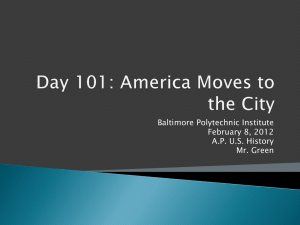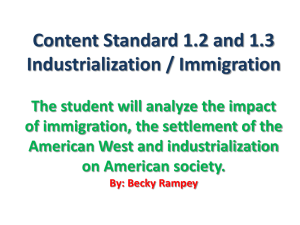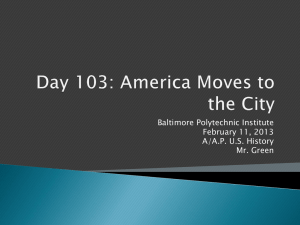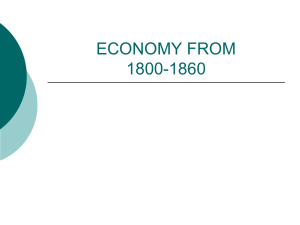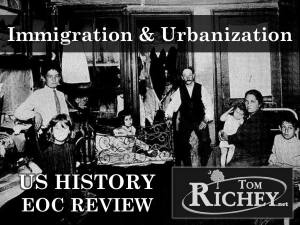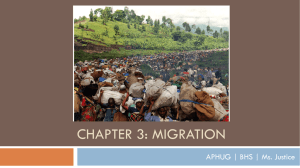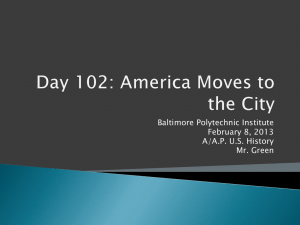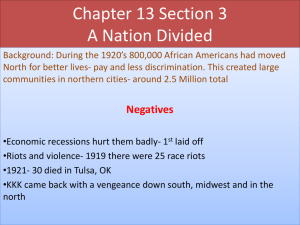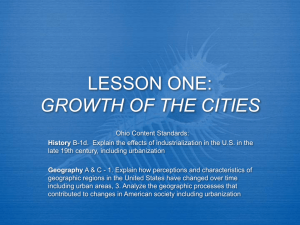Immigration
advertisement
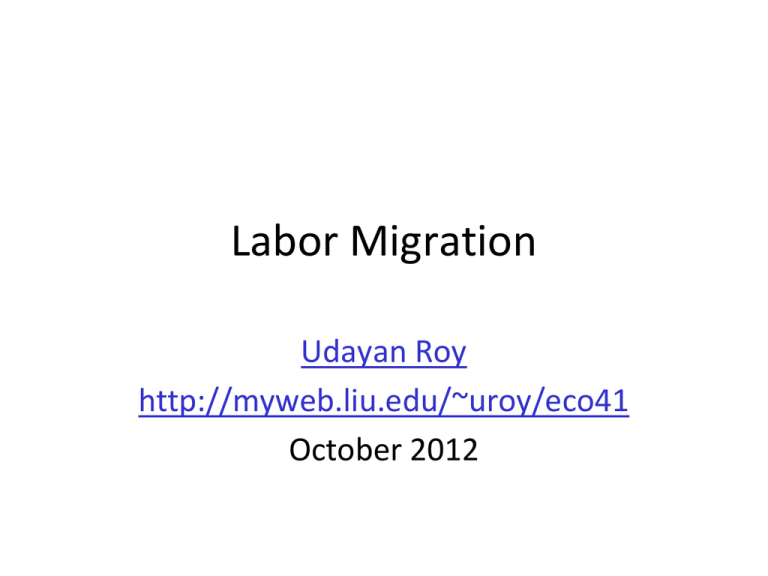
Labor Migration Udayan Roy http://myweb.liu.edu/~uroy/eco41 October 2012 Why Resources Migrate • Recall that Heckscher-Ohlin theory implies factorprice equalization • However, if the assumptions of Heckscher-Ohlin theory are not satisfied, the real price of a resource may not be equal everywhere • When the real price of a resource varies from country to country, there will be a strong economic incentive for the resource to migrate – from the low-price country to the high-price country. Recap of Welfare Economics: Willingness to Pay and the Demand Curve Price A P1 B The area under the demand curve measures the total willingness to pay of the consumers who bought Q1 units. It also measures the maximum willingness to pay that could be obtained from Q1 units C Earlier, we saw this concept applied to consumer goods, such as ice cream. But it is also true for resources, such as labor Demand 0 Q1 Quantity 18 By recalling an earlier lecture we can see that A + B represents the total value of labor (or, businesses’ willingness to pay for labor) Price of Labor, w/p But B represents the wages earned by the workers. This is (w/p)0 × L0. Therefore, A represents the surplus earned by firms. As capital is the only other resource, the surplus (A) goes to the owners of capital. In short, A + B is the total output. B goes to labor as wages, and A goes to capital as profits. A (w/p)0 Demand, which is the firms’ willingness to pay for labor B L0 Quantity of Labor, L Before and After Immigration w/phome w/pforeign A B D H E Populations before migration I F C G O Home employment J Foreign O* employment Total world labor force Populations after migration Who Gains? Who Loses? Before After (Residents) After (Citizens) Home Foreign Home Foreign Home Foreign Wages BC GJ CEFG IJ C EFGIJ Profits A FHI ABD H ABD H ABC FGHIJ ABCDEFG HIJ ABCD EFGHIJ Total Effect on Resource Prices • When a resource moves from one country (the guest country) to another (the host country), the real price of that resource – increases in the guest country, and – decreases in the host country. • For example, if labor migrates from Mexico to the U.S., – the native (or, pre-migration) workers in the U.S. will lose, and – Mexican workers, both those who left Mexico and those who stayed, will gain Effect on Complementary Resources • The real reward to any resource that is a complement to the migrating resource – increases in the host country and – decreases in the guest country. • For example, if labor migrates from Mexico to the U.S., – U.S. owners of capital will gain and – Mexican owners of capital will lose Effect of Mexican Immigration on US Wages • Recall that the host country’s complementary resource benefits from immigration • Capital may not be the only complementary resource that benefits • Landowners may benefit • Complementary labor may benefit • The biggest hit is taken by previous cohorts of immigrants, who are in direct competition with the current cohort of immigrants Overall Effect • Both the host and the guest countries benefit from the migration of resources in the sense that, in each country, the gains (to the nation’s pre-migration resources) exceed the losses. • For example, if labor migrates from Mexico to the U.S., – – – – the native (or, pre-migration) U.S. workers will lose, the U.S. owners of capital will gain, and capital’s gains will exceed labor’s losses. Conversely, Mexican workers—those that left and those that stayed— will gain, – Mexican owners of capital will lose, – labor’s gains will exceed capital’s losses. Overall Effect on the World • Since each country experiences a net gain, the world as a whole gains from the migration of resources. – See chapter 7 of the textbook, especially the section on “International Labor Mobility” Complication: inequality • Looking only at the total surplus-based analysis we have used so far is not always enough • Inequality is important too • Immigration exacerbates inequality in the host country when the immigrants are less welleducated than the average native • Restricting immigration to highly-educated foreigners reduces inequality Complication: Social Safety Net • If immigrants pay less in taxes to the host nation’s government than the host nation’s government spends on them, then citizens of the host nation may be worse off after immigration • If net government spending on immigrants exceeds D—see figure and table— immigration hurts the host nation Complication: Social Safety Net • Nordic countries—such as Sweden, Norway, and Denmark—and other countries that are small, rich, and have generous social safety nets, may be unable to sustain their way of life without restricting the entry of poor immigrants. • Allowing only the entry of highly-skilled immigrants makes sense on this point Complication: Culture • Immigrants who do not share the host country’s cultural values may – – – – Find it hard to blend in Face rejection and joblessness Turn to violence Force the host country to accept hitherto unacceptable norms • Again, allowing only the entry of highlyskilled immigrants makes sense on this point Outsourcing • Outsourcing refers to the transfer of service work previously done within the country to workers located elsewhere • This phenomenon can be analyzed exactly as we have analyzed immigration • However, the added pluses are that – these foreign workers will not drain the social safety net – And will not impose costs of cultural conflict – If they do skilled work, they will reduce inequality too Policy: Immigration by Auction • Most countries restrict immigration • In such cases the economically efficient rationing mechanism is to auction off the limited number of immigration permits Policy: educational standards • Countries such as Australia and Canada select migrants according to educational and other qualifications

